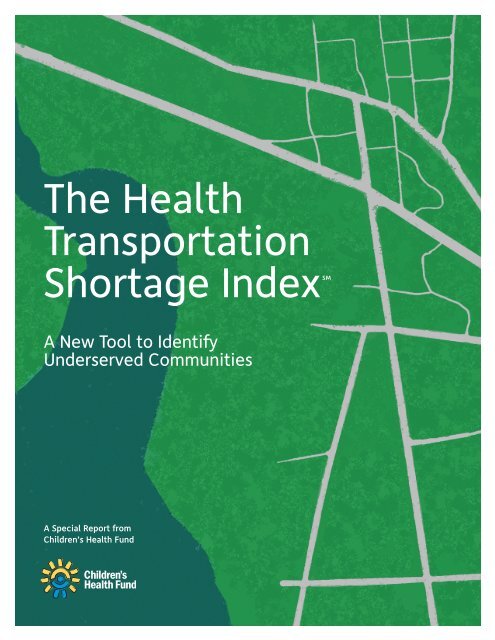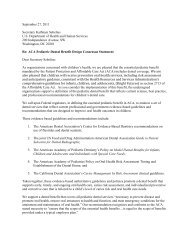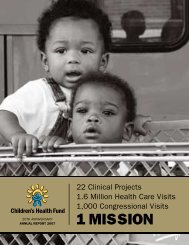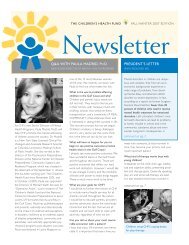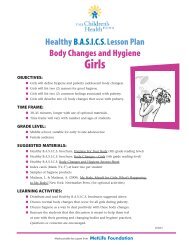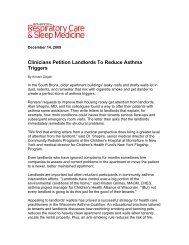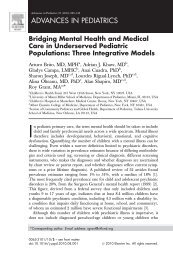The Health Transportation Shortage Index - Children's Health Fund
The Health Transportation Shortage Index - Children's Health Fund
The Health Transportation Shortage Index - Children's Health Fund
Create successful ePaper yourself
Turn your PDF publications into a flip-book with our unique Google optimized e-Paper software.
<strong>The</strong> <strong>Health</strong><strong>Transportation</strong><strong>Shortage</strong> <strong>Index</strong>SMA New Tool to IdentifyUnderserved CommunitiesA Special Report fromChildren’s <strong>Health</strong> <strong>Fund</strong>CHILDREN'S HEALTH FUNDa
<strong>The</strong> <strong>Health</strong> <strong>Transportation</strong><strong>Shortage</strong> <strong>Index</strong>SMAUTHORS• Roy Grant, MA• Dennis Johnson, MPS• Stephen Borders, PhD• CHILDREN’S HEALTH FUND, NEW YORK, NY• GRAND VALLEY STATE UNIVERSITY, ALLENDALE, MI• COLUMBIA UNIVERSITY, MAILMAN SCHOOL OF PUBLIC HEALTH• Delaney Gracy, MD, MPH• • Irwin Redlener, MDCorresponding Author: Roy Grant, Children’s <strong>Health</strong> <strong>Fund</strong>, 215 West 125th Street,Suite 301, New York, NY 10027. 212-535-9400 | rgrant@chfund.orgACKNOWLEDGMENT<strong>The</strong> authors acknowledge the important contributions of Lee Miringoff,Barbara L. Carvalho, PhD, and Stephanie Calvano of Marist College Institute forPublic Opinion; John Green, PhD, formerly of Delta State University (Cleveland, MS);Arturo Brito, MD, MPH formerly at CHF; and Tracy Rostholder, MPH at CHF.This document summarizes a more comprehensive <strong>Children's</strong> <strong>Health</strong> <strong>Fund</strong>Special Report on the development of the <strong>Health</strong> <strong>Transportation</strong> <strong>Shortage</strong> <strong>Index</strong> SM .<strong>The</strong> full report is available upon request.<strong>Fund</strong>ing for the <strong>Health</strong> <strong>Transportation</strong> <strong>Shortage</strong> <strong>Index</strong> SM :A New Tool to Identify Underserved Communitieswas provided by the W.K. Kellogg Foundation.
AbstractMost discussions of barriers to access for child health care focuson the availability of comprehensive, continuous health insurance.Other factors, however, also may pose significant barriers,including shortages of health professionals and inadequate publictransportation resources. Based on national and regional health surveydata, Children’s <strong>Health</strong> <strong>Fund</strong> has developed a new tool, the <strong>Health</strong><strong>Transportation</strong> <strong>Shortage</strong> <strong>Index</strong> (HTSI SM ), to help identify areas andcommunities where transportation shortages contribute to difficultygetting health care.<strong>The</strong> HTSI SMis based on data from a national survey and a regional survey done in the rural MississippiDelta. <strong>The</strong> national data show that each year 9% of children in families with income less than$50,000 (4% of children overall) missed at least one health care appointment annually becausetransportation was not available. In the regional survey, 10% missed a health care appointmentbecause of lack of transportation. In both surveys, nearly one-third of these children later useda hospital emergency department for the condition associated with the missed appointment.<strong>The</strong> national survey included a question asking parents if they had difficulty establishing a usualsource of pediatric care. A positive response to this was used to identify families with problemsaccessing child health care services, because difficulty establishing a usual source of care isassociated with higher rates of hospital emergency department use for routine illnesses. In thenational survey difficulty establishing a usual source of care was significantly associated with:1) rural area, 2) low income, 3) longer travel distance to source of care (especially noted inrural areas), and 4) lack of public transportation. In the regional survey, it was associated withnot having a car.Children’s <strong>Health</strong> <strong>Fund</strong> developed the HTSI SMto serve as a tool to guide users in the assessmentof the most important factors associated with transportation barriers to child health care access.<strong>The</strong> HTSI SMfactors are: 1) population as a proxy for rural area and for travel distance; 2) povertyas a proxy for automobile ownership; 3) public transportation availability; and 4) health careprovider workforce availability. Points are assigned for each factor based on area characteristicsand are added together. Higher scores indicate greater risk for transportation barriers to childhealth care access.To overcome these barriers, targeted communities should be prioritized for additional publictransit resources and/or improved coordination between health care and transportationproviders. Some potential strategies are suggested at the end of this report.CHILDREN'S HEALTH FUND1
2. <strong>The</strong> <strong>Health</strong> <strong>Transportation</strong>SM<strong>Shortage</strong> <strong>Index</strong> (HTSI )<strong>The</strong> HPSA designation reflects the ratio of health care providersto population. <strong>The</strong>re is no comparable measure to identify areasthat lack transportation to support health care access. Focusingon child health care access, Children’s <strong>Health</strong> <strong>Fund</strong> (CHF) hasdeveloped a tool to identify transportation shortage areas, the<strong>Health</strong> <strong>Transportation</strong> <strong>Shortage</strong> <strong>Index</strong> (HTSI SM ). This will supplementthe HPSA designation and target communities in need of additionalhealth transportation resources.<strong>The</strong> HTSI SMis a simple instrument that health planners can use to identify areas of the countrywhere transportation shortages are likely to impact child health care access. Its designreflects the results of national and regional survey research. Based on these findings, four riskfactors characteristic of areas with transportation shortages were identified.<strong>The</strong> HTSI SMis designed to capture the cumulative impact of these risk factors for child healthcare access barriers: 1) type of geographic area (based on population); 2) child poverty;3) transportation availability; and 4) workforce (health professional shortages).Each factor is scored from zero to four using data that are readily available. Population andpoverty data are available from the U.S. Census Bureau. Area scoring is done in accordancewith population thresholds for area type from the U.S. Department of Agriculture. HPSAdesignation may be ascertained online from the <strong>Health</strong> Resources and Services Administration(HRSA). This site also lists safety net health care sites (federally qualified health centers, ruralhealth clinics). Additional information may be available from state Primary Care Associationwebsites. Public transportation by county (and often by area within county) is generallyavailable online for each state. Personal vehicle ownership is strongly correlated with income:a higher percentage of population in poverty is associated with a higher percentage ofpopulation with no owned automobile. <strong>The</strong> poverty factor therefore serves as a proxy forautomobile availability.CHILDREN'S HEALTH FUND3
<strong>The</strong> <strong>Health</strong><strong>Transportation</strong><strong>Shortage</strong> <strong>Index</strong>SMRate each of these 5 factors associated with transportation andhealth care access in points, as indicated, and add the points for theHTSI SM score. A total score of 6 or higher indicates a transportationshortage area. <strong>The</strong> higher the score, the higher the risk fortransportation-related barriers to child health care access.1 Type of area, based on population(using Census Bureau population data)4 HPSA designationYES2 pointsRURAL4 pointsENTIRE GEOGRAPHIC AREAPOPULATION ≤ 5,000YES1 pointSMALL TOWN3 pointsPARTIAL GEOGRAPHIC AREAPOPULATION > 5,000 AND ≤ 10,000NO0 pointsSMALL CITY2 pointsPOPULATION > 10,000 AND ≤ 20,000URBAN AREA1 point 5 FQHC in area (for high poverty areas;POPULATION > 20,000 AND ≤ 50,000include rural health clinics)METROPOLITAN AREA0 pointsPOPULATION > 50,000NO2 pointsONE1 point2 * TWO OR MORE0 pointsChild poverty rate (% in poverty)exceeds US (using most currentNOT APPLICABLE0 points(NOT A HIGH POVERTY AREA)available data)YES3 pointsBY 1.25X OR GREATERYES2 pointsBY LESS THAN 1.25XSAME AS US1 pointLOWER THAN US0 points* NOTES:3 Public transportation availability1. <strong>The</strong>re is a strong negative correlation between poverty andautomobile ownership (i.e., higher poverty rate is associated withNONE3 pointslower personal vehicle ownership). <strong>The</strong> HTSI SM incorporates personalvehicle ownership through the poverty factor as a component ofDEMAND-RESPONSE2 pointsassessing available transportation resources.(E.G., PARATRANSIT)LIMITED1 point2. If child poverty rate is not available for an area, family or(DOES NOT RUN FULL-TIME AND/ORROUTES DO NOT COVER TARGET AREA)YES0 pointshousehold poverty rates may be used as representative becauseof the strong correlation among these three indicators.
Data Sources forSMHTSI Scoring<strong>The</strong> following are suggested sources to obtain data for use in scoringthe HTSI SM . For most data points, multiple sources are available. <strong>The</strong>serecommended sources have proven reliable; however, when morethan one source is consulted, further investigation may be necessaryto resolve possible contradictions.1 Type of area, based on populationSOURCE: 2010 UNITED STATES CENSUS BUREAU DATASpecifically the Interactive Population Map isrecommended and yields data for designated geographicareas, e.g., county or Zip Code. This can be found at:http://2010.census.gov/2010census/popmap. <strong>The</strong>re is alink from this page to the American Factfinder 2010 Censussearch page which can also be used. This can be found at:http://factfinder2.census.gov/faces/nav/jsf/pages/index.xhtml45HPSA designationSOURCE: HRSA WEBSITEThis can be found at: http://hpsafind.hrsa.govFQHC in area (for high poverty areas;include rural health clinics)SOURCE: HRSA WEBSITE2Child poverty rateSOURCE: 2010 UNITED STATES CENSUS BUREAU DATAChild poverty data are not uniformly available for allgeographic areas. It may be necessary to substitute datafor Families with Related Children Under 18. If 2010 Censusdata are not available for this category, the Census BureauAmerican Community Survey (ACS) can be used. <strong>The</strong>American Factfinder search page can be used to findACS data for county or Zip Code. This can be found at:http://factfinder2.census.gov/faces/nav/jsf/pages/index.xhtmlTogether with HPSA status, federally qualified healthcenters and other health resources are listed at thissite: http://findahealthcenter.hrsa.gov/Search_HCC.aspx?byCounty=1. A list of rural health centers is availableat: https://www.cms.gov/Outreach-and-Education/Medicare-Learning-Network-MLN/MLNProducts/downloads//rhclistbyprovidername.pdfAn additional source is each state’s specific Primary CareAssociation (PCA) Website, using the Community <strong>Health</strong>Centers link.3Public transportation availabilitySOURCE: SPECIFIC WEBSITE FOR EACH STATEA Google search of public transportation in each stateis likely to yield useful results including links to transitresources. State Government websites often have links tothat state’s Department of <strong>Transportation</strong>. <strong>The</strong>re is a pageon the American Public <strong>Transportation</strong> Association (APTA)website with links to information on transit resourcesin each state. This can be found at: http://apta.com/resources/links/unitedstates/Pages/default.aspxCHILDREN'S HEALTH FUND5
3. National and regional dataSMthat support the HTSI<strong>The</strong> HTSI SMwas developed using datafrom a national survey by CHF andthe Marist College Institute for PublicOpinion designed to determine thescope of the problem and identifyfactors associated with transportationbarriers to child health care access. 3Further information was obtained atthe local level using a similar surveyin the Mississippi Delta.NATIONAL SURVEY DATAFor access, the proxy used was difficulty findinga usual source of pediatric care. Difficulty findinga usual source of care is significantly associatedwith preventable hospital ED use, especially in ruralcommunities. 4<strong>The</strong> survey also provides data on the availabilityof transportation resources, revealing a wide andstatistically significant variance in availability ofpublic transportation among types of communitiesacross the country. <strong>The</strong> range is from a low of 25%with public transit resources in rural areas to a highof 91% in big cities (p
Travel distance emerged as a significant factorassociated with health care access problems.On average parents reported a travel distance ofnine miles to their usual source of pediatric care,with 35% having to travel ten or more miles.Travel distance was significantly greater in ruralcommunities and small towns compared to urbanareas (p
SM4. Validating the HTSI<strong>Health</strong> professional shortage areasare generally also high poverty areas,and poverty is associated with higherrates of chronic illness. For children,this often means higher prevalenceof conditions such as asthma,combined with worse access toprimary care resources to bring thecondition under control. Hospital usefor asthma reflects poor primary caremanagement, and a disproportionatepercentage of pediatric asthmaED visits and hospitalizations eachyear are for children living inpoverty. Thus, asthma is an exampleof an ambulatory care sensitivecondition (ACSC), as it is generallymore appropriately and effectivelymanaged in primary care settings. 6-8We validated the HTSI SMusing a database thatincorporated hospital discharge data and usedthe rate of pediatric ACSC-related ED use for theoutcome variable as a proxy for access. <strong>The</strong> locationof federally qualified health centers and publictransportation routes and stops were mappedusing GIS software. <strong>The</strong> hospital discharge datawere obtained from the Texas Department of State<strong>Health</strong> Services and focused on three metropolitanareas, Austin (Travis County), Dallas (Dallas County),and Houston (Harris County). <strong>The</strong>se counties wereselected because of their mix of urban and ruralareas and the availability of a relatively completedata set. Data were generally unavailable for highlyrural areas. Target areas (“hot spots”) were those inwhich the three year average rate of ACSC-relatedED use was above the 75th percentile. In practice,the HTSI SMcorrectly identified areas with high ACSCrelatedED use.<strong>The</strong> mean child poverty rate in the hot spot areasin Harris County was 57% higher than that in areaswith the lowest rates of ACSC-related ED use, andwas more than 25% higher than the U.S. childpoverty rate. Hot spots were significantly morelikely to be rural than urban areas. In Travis County,ACSC-related ED rates were significantly higherin rural areas and in areas with longer distancesfrom the nearest health center and public transitroutes. At the ZIP Code level, higher ED rates wereassociated with higher percentages of householdswith no personal vehicle.Finally, as part of the GIS mapping strategy,multiple factor analyses were done to determinecorrelations among key variables so those thatwere redundant to the analysis could be excluded.<strong>The</strong>re were strong correlations between householdincome and automobile ownership, and betweenrural area designation and longer travel distances.Higher household poverty was strongly associatedwith lower car ownership (p=0.001), so this scoringalgorithm effectively incorporates car ownershipthrough the poverty factor. Rural area designationbased on low population is strongly associated withgreater travel distance to health care (p=0.001),so distance is incorporated in the HTSI SMthroughthe area factor, with rural designation as a proxyfor longer travel distance.8 <strong>The</strong> <strong>Health</strong> <strong>Transportation</strong> <strong>Shortage</strong> <strong>Index</strong> SM
5. Conclusion andRecommendationsMost discussions of barriers to child health care access focus on whether the child has healthinsurance. Strategies to improve access therefore focus on expanding the pool of insuredchildren. This has been effectively achieved through state child health insurance programs,expanded Medicaid eligibility, and is expected to continue when key features of health reformare implemented. Having an insurance card, however, is not enough. In high poverty, lowhealth care workforce areas, families must typically travel long distances to get to a healthcare facility and often do not have adequate transportation to make this possible.<strong>The</strong> Children’s <strong>Health</strong> <strong>Fund</strong> <strong>Health</strong> <strong>Transportation</strong> <strong>Shortage</strong> <strong>Index</strong>(HTSI SM ) is designed to supplement the <strong>Health</strong> Professional <strong>Shortage</strong>Area (HPSA) designation by identifying areas for the infusion ofadditional transportation resources to facilitate child health careaccess. <strong>The</strong> cost of additional transit services is expected to bemore than compensated over time by savings attributable toreduced reliance on hospital emergency departments for routineor other non-urgent care. <strong>The</strong> HTSI SMis a simple tool that reflectsthe cumulative impact of risk factors associated with barriers tochild health care access and higher rates of hospital emergencydepartment use: type of area, poverty, transportation resources, andworkforce availability. It can be used to highlight counties or smallergeographic areas for best allocation of resources to improve childhealth care access.As these solutions to improve health care access should include specific steps to enhance thearea’s transit infrastructure, recommended strategies are presented on page 10 and 11.CHILDREN'S HEALTH FUND9
Potential Strategies to Reduce<strong>Transportation</strong>-Related <strong>Health</strong> CareAccess Barriers1. Improve Medicaid NEMT servicesNon Emergency Medical <strong>Transportation</strong> (NEMT) is integral to the Medicaid program.Relative to need, this key component of Medicaid is under-funded and under-utilized.States have discretion as to how they will provide NEMT services and could increaseits availability, better market the service, and loosen regulatory restrictions to increasetransportation access to health care services.2. Coordinate existing transportation resources (mixed-use model)In 2004, a federal inter-agency initiative was launched to support increased coordinationand integration of existing federally-subsidized transportation resources through expandeduse of vehicles targeted for specific populations (e.g., the elderly) or programs (e.g. HeadStart). When these vehicles are idle they could be made available for other purposesincluding health care service access.3. Develop hybrid demand-response transit systems<strong>The</strong> available transportation infrastructure in rural communities is often chiefly comprisedof demand-response or paratransit systems. To improve access to health care services,these may be expanded to link geographically isolated areas with available fixed routetransit systems. Using paratransit “feeders” would increase public transit utilization andfacilitate mobility to and from locations distant from fixed route transit stops.10 <strong>The</strong> <strong>Health</strong> <strong>Transportation</strong> <strong>Shortage</strong> <strong>Index</strong> SM
4. Coordinate health care scheduling with transportation availabilityImproved scheduling strategies at the health care site can ensure that health careappointments are arranged for times when transportation is available and accessible.As part of case management and care coordination activities at the health care site,the capacities of emerging health information technology may soon include the abilityto simultaneously schedule a health appointment and transportation to get there.5. Increase investment in public transportationAvailability of public transportation strengthens access to health care in medicallyunderserved communities. Research conducted by the Community <strong>Transportation</strong>Association determined that millions of Americans use public transit as their primarymethod of reaching a health care destination. As national focus is increasingly onoutpatient care, the need for expanded public transportation is clear. Other benefitsof public transit systems include less air pollution and reduced reliance on foreign oil.6. Develop a “<strong>Transportation</strong> <strong>Shortage</strong> Area” designation<strong>The</strong> <strong>Health</strong> <strong>Transportation</strong> <strong>Shortage</strong> <strong>Index</strong> SMmay be used to identify and target areas thatlack an adequate transportation infrastructure to support health care access. Appropriatesolutions may then be developed through ongoing dialogue among health care andtransportation professionals and community stakeholders. <strong>The</strong> HTSI SMcould act as a triggerfor additional federal, state and local resources to enhance health care service access.CHILDREN'S HEALTH FUND11
6. References1. P Hughes-Cromwick, R Wallace, H Mull, J Bologna. Cost Benefit Analysis of Providing Non-Emergency Medical <strong>Transportation</strong> (Project B-27). 2005. Altarum Institute. Available online at:http://altarum.org/files/pub_resources/05_project_report_hsd_cost_benefit_analysis.pdf.Accessed March 22, 2011.2. Borders, S. <strong>Transportation</strong> Barriers to <strong>Health</strong> Care: Assessing the Texas Medicaid Program[Ph.D. Dissertation]. 2006. College Station: Texas A&M University. Available online at:http://repository.tamu.edu/bitstream/handle/1969.1/6016/etd-tamu-2006A-URSC-Borders.pdf?sequence=1. Accessed April 22, 2011.3. Random Digit Dial (RDD) Equal Probability Selection Method (EPSEM), Random A telephone surveyof 1,819 adults 18 years of age and older within the continental United States; 610 were parentswith children age 18 and under living in their household. Interviews were conducted September18th through 21st, 2006 in English and Spanish. <strong>The</strong> results of the entire survey are statisticallysignificant at ±2.5% and ±4.0% for parents with children age 18 and under. Weighted analyseswere done in SPSS Version 15.0. Columbia University Institutional Review Board Number AAAB5764applies to this survey research.4. JH Sarver, RK Cydulka, DW Baker. Usual Source of Care and Non-Urgent Emergency DepartmentUse. Academic Emergency Medicine. 2002; 9: 916-923.5. <strong>The</strong> Delta Rural Poll was conducted in February 2011 by Wolfgang Frese Survey ResearchLaboratory at Mississippi State University in collaboration with the Delta State University Divisionof Social Sciences and Center for Community and Economic Development. <strong>The</strong> counties surveyedwere Bolivar, Coahoma, Humphreys, Issaquena, Leflore, Quitman, Sharkey, Sunflower, Tallahatchie,Tunica, and Washington. Random digit dial methodology included households with unlistednumbers. <strong>The</strong> margin of error for the full data set (N=1008) is +/- 3%.6. LJ Akinbami, JE Moorman. Asthma Prevalence, <strong>Health</strong> Care Use, and Mortality: United States,2005-2009. National <strong>Health</strong> Statistics Reports #32. January 12, 2011. Available online at:http://cdc.gov/nchs/data/nhsr/nhsr032.pdf. Accessed December 5, 2011.7. Akinbami LJ. <strong>The</strong> State of Childhood Asthma, United States, 1980-2005. Centers for DiseaseControl & Prevention (CDC). Advance Data # 381. Revised December 29, 2006. Available online at:http://cdc.gov/nchs/data/ad/ad381.pdf. Accessed December 5, 2011.8. Gendo K, Lodewick MJ. Asthma economics: focusing on therapies that improve costly outcomes.Current Opinion in Pulmonary Medicine. 2005; 11:43–50.
Children’s <strong>Health</strong> <strong>Fund</strong> is committed to providinghealth care to the nation’s most medically underservedchildren through the development and support ofinnovative primary care medical programs; response topublic health crises; and the promotion of guaranteedaccess to appropriate health care for all children.
215 West 125th Street, Suite 301 | New York, NY 10027 | 212-535-9400 | childrenshealthfund.org© 2012 CHILDREN'S HEALTH FUND. ALL RIGHTS RESERVED.


